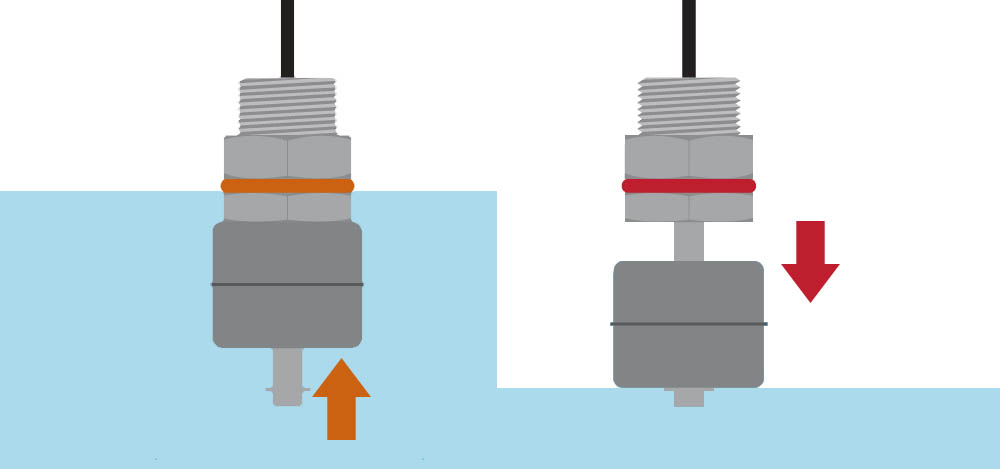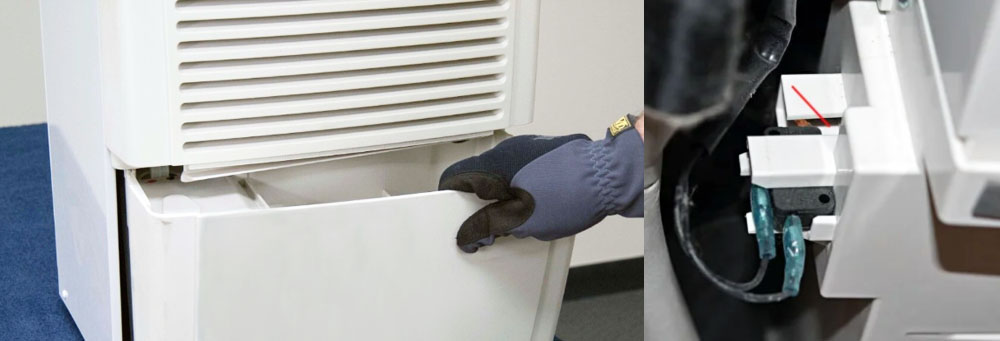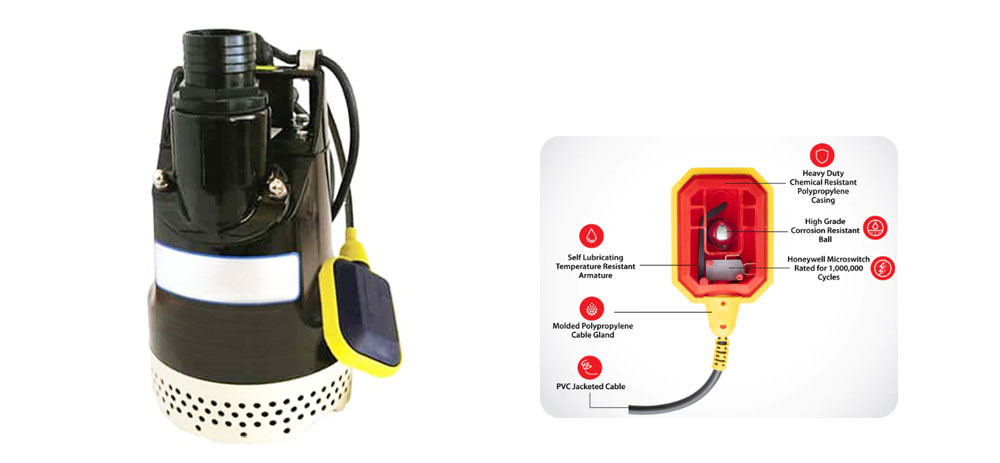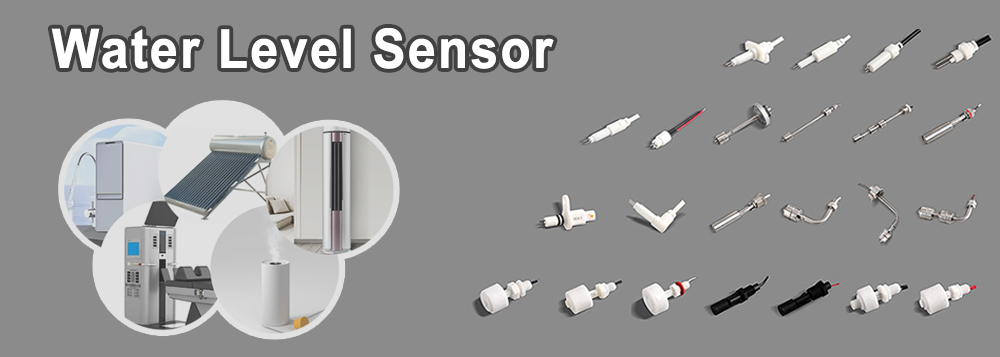Water level float switches also called float sensors are devices that are used to detect the level of liquid in a container. They are often used in applications such as pumps, water tanks, and industrial processes.
How do float switches work?
A float switch typically consists of a buoyant object, or “float”, attached to a switch mechanism. The float is made of a material with a specific gravity that is less than the liquid being measured. When the liquid level rises, the float rises with it, and when the liquid level falls, the float falls as well.
The switch mechanism is usually either a reed switch or a microswitch, which is activated when the float reaches a certain height. This height is set by adjusting the position of the switch mechanism along the float stem.

When the float reaches the set height, the switch mechanism is triggered and it sends an electrical signal to a control system or a pump motor, which activates or deactivates the pump or other devices.
Float switches can be designed to work in a variety of liquid types, including corrosive or explosive liquids, and can also be used in a variety of orientations, including vertical or horizontal. They are reliable and relatively simple devices, making them widely used in various industries.
The Float Switches Types
There are several types of float switches available, each with their own unique characteristics and applications. Some of the most common types of float switches include:
- Vertical Float Switches: This type of float switch consists of a buoyant float attached to a lever arm. As the liquid level rises, the float rises with it, causing the lever arm to pivot and activate a switch.
- Horizontal Float Switches: These float switches use a similar mechanism to vertical float switches, but the float is positioned horizontally instead of vertically. This type of float switch is often used in applications where vertical space is limited.
- Tilt Float Switches: Tilt float switches use a ball or cylindrical float that tilts when the liquid level rises or falls. The tilt mechanism activates a switch that can be used to control pumps, alarms, or other devices.
- Electronic Float Switches: These float switches use sensors to detect changes in the liquid level and transmit a signal to a control system. They are often used in applications where precise control is required, such as in wastewater treatment or chemical processing.
- Magnetic Float Switches: This type of float switch uses a magnetic field to detect changes in the liquid level. The float contains a magnet that activates a switch when it comes into contact with a reed switch located outside of the liquid.

The type of float switch used will depend on the specific application and the requirements of the system. Factors such as the type of liquid, the size and shape of the container, and the required accuracy of level detection will all play a role in selecting the appropriate type of float switch. Apart from these types, now also has some water level switches that can be used in the dishwasher and washing machine.
Find the location of a float sensor
The float switch on a dehumidifier is usually located in the water collection bucket or tank. The float switch is a small device that is designed to detect when the bucket or tank is full of water and shut off the dehumidifier to prevent overflow.
When the water in the collection bucket reaches a certain level, the float switch will be triggered and it will stop the dehumidifier from running until the bucket is emptied. Some dehumidifiers may also have a mechanism to alert you when the bucket is full and needs to be emptied.
It is important to regularly check the collection bucket and empty it when necessary to ensure that your dehumidifier continues to function properly and effectively.

Where is water level float switch in LG dishwasher?
The location of the float switch in an LG dishwasher may vary depending on the model, but in general, it is located in the bottom of the dishwasher tub, near the front. The float switch is a small component that detects the level of water in the dishwasher and controls the operation of the dishwasher’s water inlet valve.
To locate the float switch in your LG dishwasher, you may need to consult the owner’s manual or look for a diagram of the dishwasher’s parts. In general, you should be able to find the float switch by removing the lower front panel of the dishwasher and looking for a small, plastic device that is attached to the bottom of the tub.
If you are having problems with your LG dishwasher and suspect that the float switch is the issue, it may be best to consult a qualified appliance repair technician to diagnose and fix the problem.

Where is float switch on sump pump?
The location of the float switch on a sump pump can vary depending on the specific model and design of the pump. However, in general, the float switch is typically located inside the sump pit, which is the basin or container that collects water and other liquids that need to be pumped out.
The float switch is a small, buoyant device that floats on the surface of the water in the sump pit. As the water level rises, the float switch also rises, triggering the pump to turn on and begin pumping the water out of the pit.
In some sump pumps, the float switch may be attached to the pump itself, while in others it may be connected by a flexible cord or cable that runs from the switch to the pump.
If you’re having trouble locating the float switch on your sump pump, consult the owner’s manual or contact the manufacturer for more information.

How to connect water level float switch to submersible pump?
To connect a float switch to a submersible pump, follow these general steps:
- Gather the necessary materials: You will need a float switch, submersible pump, wire cutters, electrical tape, and wires.
- Identify the connections on the float switch: There should be two wires coming out of the float switch. One wire is for the “Normally Open” (NO) connection, and the other is for the “Common” (COM) connection.
- Identify the connections on the submersible pump: There should be two wires coming out of the pump, usually red and black.
- Connect the wires: Connect the red wire from the pump to the NO connection on the float switch. Connect the black wire from the pump to the COM connection on the float switch. Use wire cutters to strip the ends of the wires, and twist the exposed wire ends together. Cover the exposed wire ends with electrical tape.
- Secure the connections: Use zip ties or clamps to secure the wires and prevent them from coming loose.
- Test the float switch: Fill a bucket or container with water and place the float switch inside. Turn on the submersible pump and make sure it turns off when the water level reaches the desired level and the float switch is triggered.
By following these steps, you can connect a float switch to a submersible pump and ensure that your pump only turns on when needed and prevent it from running dry.
All in all, the water level float switch is switch can help the device to detect the liquid level, which plays an important role in the system. Zing Ear as a group company, we have many factories to produce all kinds of switches, welcome to visit our product page or click the picture to see more float switches or other switch products.

